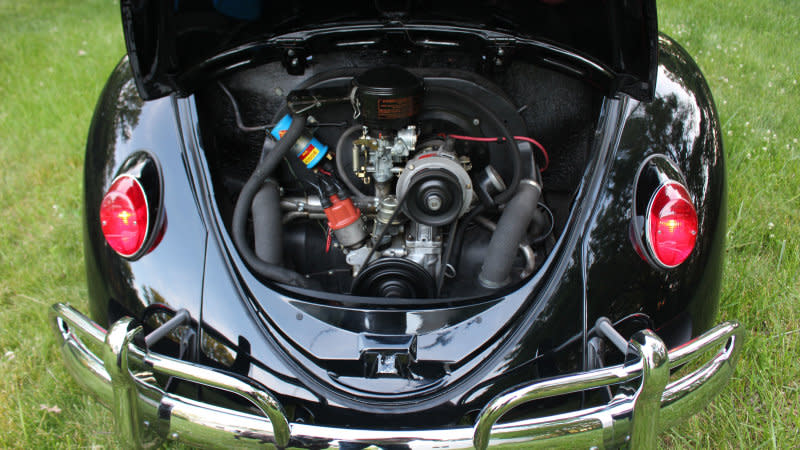Meet the Beetles: We drive VW Bugs from 1964 and 2013

As you may have seen, we’ve been running a series of stories on classic Volkswagens including the Karmann Ghia and the original GTI. And now we come to the most famous of VWs, the Beetle, a 1964 example to be precise. It also happened to arrive in my driveway at the absolute perfect time, since I just recently bought a 2013 VW Beetle of my own. As such, this was a great opportunity to see just how much of a difference, or lack thereof, about 50 years makes in a car.
Right off the bat, there’s an obvious familial resemblance to the two cars. In fact, my 2013 Beetle, which had been fully redesigned for the previous year, looks more like the original than the 1998 "New" model that revived the nameplate. It has a short, upright windshield, a long hood, a roofline that curves down to the bumper, and big, bulbous fenders. Certainly the original is much narrower, shorter in length and has more detailing in its hood and engine compartment lid stampings, but both are instantly recognizable as Beetles.
Step inside both Bugs, and you find even more similarities. Each have shallow, upright painted dashboards (or a really fake-looking carbon fiber pattern in my 2013 version) and even a glovebox right at the top of the dash. Look behind you in either car and you’ll find the trademark grab straps.
But the interior is also where many differences start to show up. In the '64, you got three instruments: a speedometer with an odometer, and a fuel gauge. This was actually a big step up from older Beetles that had no fuel gauge, simply a switch to engage the reserve fuel tank when the primary one was drained. In my 2013 VW Beetle, I have a speedometer, tachometer, fuel gauge, oil temperature gauge and boost pressure gauge. And those are just the analog ones. There’s also a multifunction display that can provide coolant temperature, fuel economy and multiple trip odometers. And sandwiched between the oil temperature and boost gauges is an honest-to-goodness stopwatch, sort of a discount version of the Porsche Sport Chrono package.
There’s more … more in the 2013 Bug, too. It has a six-CD changer, AM/FM and satellite radio capability, heated seats, a sunroof and not only air conditioning, but reliable heat, too. For entertainment in the ’64, you get an AM radio, for cooling you have vent windows, and for heat, you have a knob by the shifter that if you're lucky will channel some hot air from the engine bay to the cabin. My next-door neighbor who grew up with Beetles confirmed they weren’t very effective, and his dad bought a gas heater for the family Bug to keep his mom warm. Surprisingly effective are the vent windows. On the relatively hot and humid day that I drove the ’64, I was quite comfortable as long as the car was moving.
The old Bug has vinyl-covered front bucket seats with only fore and aft adjustments, and the ability to fold forward for rear access. In 2013, you got fore and aft sliding, reclining, height and even lumbar adjustment. Plus, the modern car has some light bolstering and comfortably shaped foam whereas the classic has extra soft steel springs and not a hint of lateral support, which is particularly noticeable in corners.
Needless to say, driving these cars is wildly different and it starts with their completely opposite powertrains. The '64 had a carbureted, air-cooled flat-four displacing 1.2 liters and sending just 40 horsepower and 56 pound-feet of torque to the rear wheels. Fifty years later, my Beetle has a turbocharged, direct fuel-injected inline-four with 800 cc more displacement producing a comparably monstrous 210 horsepower and 207 pound-feet of torque. The engine is also water-cooled and sits up front powering the front wheels.
Firing up the air-cooled engine can occasionally be finicky, requiring a bit of throttle application to kick on. Once running, it sounds like a cross between a Subaru and a diesel engine: lots of mechanical popping and clattering. And as the revs build, those noises are accompanied by a whooshing whistle of the belt-driven cooling fan. The turbo engine, in contrast, fires up instantly every time (via a push-button no less), and runs far smoother and quieter. Revving it up brings a hint of turbo whistle and a fair amount of intake growl.
Driving the classic Beetle feels like everything is in slow motion. The engine of course doesn’t move the car with any immediacy at all, but it’s more than just that. The steering is loose on center with a bit of play and has a very slow ratio, with the latter likely helping overcome the lack of power assist. And as you move around corners, the car slowly and steadily leans over, farther and farther, tilting you out of the seat. The shifter doesn’t move quickly from gear to gear either, and second gear in this car was stubborn. The notchy, vague lever action was at least low effort, and once practiced, gear changes could be done with just fingertips. Despite the slowness, or maybe because of it, finding the rhythm of the car was very satisfying. And it did keep up with traffic fine, and even would cruise comfortably at 65 to 70 mph on the interstate. The brake and clutch, both without any power assist, had amazing feedback and felt superb, and the ride quality is soft and soaks up bumps with aplomb. Part of the comfort may have to do with the softly sprung seats, too, though. Most amazingly, the car felt rock solid with nary a creak or rattle. Then again, there isn’t much in the car to creak or rattle.


 Yahoo Autos
Yahoo Autos 